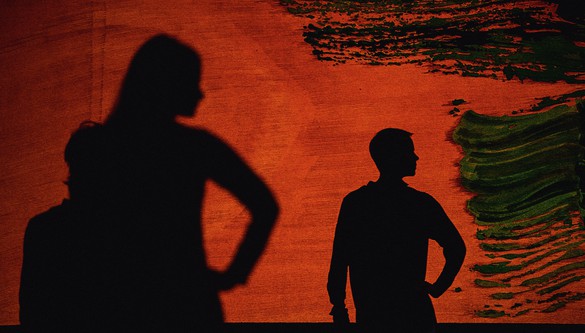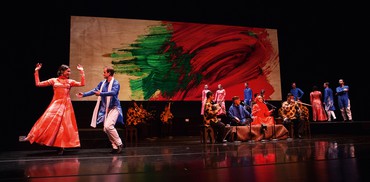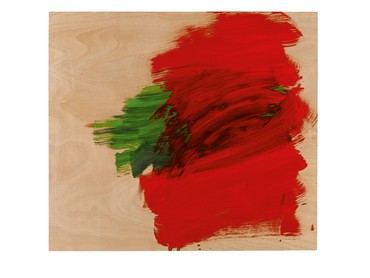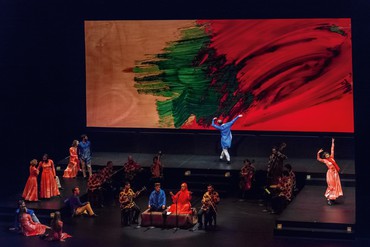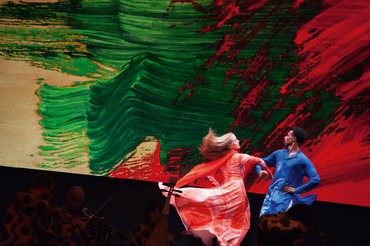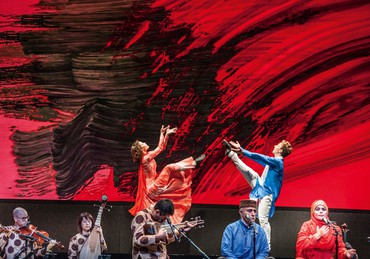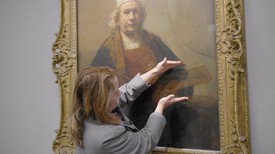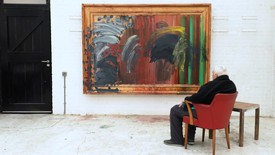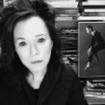
Nancy Dalva is a writer and documentary filmmaker who lives in New York City.
As the Summer 2017 Gagosian Quarterly was in production, Sir Howard Hodgkin died, at the age of eighty-four, in London. I had interviewed him a few months earlier in Berkeley, California, at the premiere of the Mark Morris Dance Group’s Layla and Majnun, on which he had been a crucial collaborator. Howard was an interviewer’s dream—he wouldn’t unpack the meanings of his paintings for you, but he talked freely about artmaking, process, the way and the why of his work, and the more general notions and feelings beneath the form. I feel profoundly bereft—such was his power, in person and in paint.
—ND
Prelude
Zellerbach Hall, a home-away-from-home in Berkeley for the Mark Morris Dance Group, is at capacity, the audience rustling and settling. In their midst sits an endearing and gallant figure in an emerald-green silk shirt that brings out his brilliant blue eyes: the artist responsible for the evening’s decor and costumes, Sir Howard Hodgkin. This is his fourth collaboration with Morris; the first was Rhymes with Silver (1997), next Kolam (2002), then the three-act Mozart Dances (2006), and now, in the fall of 2016, Layla and Majnun. The previous week, Hodgkin had been at the Mark Morris Dance Center in Brooklyn, seeing and hearing the work outside the framing stagecraft that amplifies it. He is nothing if not all in—immersed, dedicated, given to the kind of sardonic and sagacious and understated merriment of a person who exists in a resolute equilibrium.
At the dress rehearsal in Berkeley, Hodgkin had sat as close as he could get to the stage. But on opening night he moved all the way to the back—assured of the detail, he took in the larger scene. There were traditional Azerbaijani singers, weaving a melodic spell. There were English surtitles telegraphing a story known throughout the Middle East, in Muslim, Sufi, and Hindu cultures, and most recently retold in Indian movies. (Morris and Hodgkin had worked from a translation of the Persian version of the story by the twelfth-century poet Nizami Ganjavi, whose epic is considered one of the classic works of Sufi literature.) There were the raucous and fabulous musicians of the Silk Road Ensemble, center stage. To the sides there were staircases with wide landings, and at the back a raised walkway, or danceway. And there were of course dancers, surging and coursing about in Hodgkin-designed costumes—all in all, an elaborate show-and-tell, with shifting layers and levels, like some kind of magical and colorful storybook come to life.
Behind everything hung an outsize version of the painting Hodgkin calls Love and Death. On a grained background, a swirling sea of red is overlapped by a smaller series of jagged, urgent currents of green. Which, a viewer might ask, was love, and which was death? Are those green pastures the Elysian Fields, and is that the heart itself beating? Or is that springtime, and over there, a sea of blood? Et in Arcadia ego?
Just that morning, the artist sat with me for tea and an interview. His affable and erudite partner, the musicologist Antony Peattie, occasionally joined in from a nearby sofa. The first thing Hodgkin said was that he didn’t remember how he had met Morris. Some weeks later, in a different yet curiously similar interview, Morris said the same thing about him. The choreographer, the painter—are they so unalike, but for dancing’s evanescence? Surely a painting is frozen choreography—the artist’s dance before the canvas suspended in time.
Hodgkin rebelled against the austerity of abstract art and instead put the human self, in all its desire and suffering, at the center of his universe.
Jonathan Jones, The Guardian
Nancy Dalva Would you say that your art and Mark’s have things in common?
Howard Hodgkin Yes.
NDWhat are they?
HH That—that I can’t answer.
NDOh please. Make it up.
HH[laughs] I can’t.
NDWell, I’ll make some suggestions and you could say yes or no?
HHYou’re an outside observer [laughs].
NDOh, come on! Would you say that both of you are more interested in shape than line?
HHYes.
NDThe response to your work is so immediate and visceral and it’s filled with delight. In that way I think it’s like the choreography—it’s immediate. You don’t have to thrash through a thicket of ideas to get at it.
HH I accept that absolutely.
Antony PeattieAnd both Mark and Howard allude to narrative—and to object and representation—and then kind of skitter away from it. So some of the dances are telling a story and some simply—
HHAren’t.
NDI feel as if the narrative arc is there and you dip in and out of it.
AP Exactly.
HHYes, I think that’s absolutely what happens.
ND Morris has always been called a postmodernist—to me that’s because he’s the ultimate ecumenicist, he sees everything as equal. It’s like when Dido says to Aeneas, “Trojans and Tyrians are alike to me.” Everything’s alike to Morris: folk dancing, ballet, it doesn’t matter. Everything—
HHCan be—
NDUsed.
HHUsed. Exactly. I feel like that very much when I’m working, because painting as I do now, which with age has become much more straightforward, anything can be used.
NDWhat kinds of things are you using?
HHOh, the same old things as always. But with age, color and shape and so forth become more accessible.
NDWhy? Or how?
HHHelp, Antony.
APWell, you were saying that you can use anything. So you mean, for example, accident, different gestures, hands or—
HH Always.
AP —brushes, or—
HH Yes.
AP You feel freer.
HH Age has freed everything up in the most extraordinary way.
ND Tell me, has your way of working with Mark Morris changed over time?
HH It hasn’t fundamentally changed, but I think we both trust each other far more than you do when you’re strangers in the beginning.
ND How do you work together?
HHUsually he begins by telling me about some music.
ND Do you then listen to it?
HHYes.
NDHow much of your painting is a response to the music?
HHI can’t really say.
NDAre you aware of it as you’re creating the decor?
HHNo.
NDWhat about the story?
HHAh. Well, that was different.
NDDifferent from your other collaborations?
HHYes. I couldn’t think quite how I could do something as narrative as Layla and Majnun, and then one day, having sort of tried to work it out through a not very good translation, I suddenly realized, it’s all about love and death.
NDWell, that’s simple.
HHYes [laughs]. Exactly. And that meant suddenly I could do it.
NDSo you need a large topic.
HHOh yes. Definitely. Always. And then—all art is really a communication of some kind or other. I wanted to encapsulate it somehow.
NDHow did you make the painting that was the model for the backdrop? One sees this background material—a graininess that seems to be the ground?
HHYeah, you’re quite right.
NDWhat do you paint on?
HHWood.
NDAlways?
HHVirtually always now.
NDWhen did that start?
AP’75 or ’6, and the first picture was inspired by India.
Howard Hodgkin was one of the great artists and colorists of his generation.
Nicholas Serota
NDHow is it—this is not a yes or no question—how is it that on a flat surface, without going into any of the vanishing-point perspectives that were the devices of those who preceded you, you create such a sensation of volume? Craft, right?
HHYes, I think that is exactly what I do. But I can’t say how.
NDI suppose it’s like asking a tree how it does photosynthesis [laughter].
HHI think that’s exactly right.
NDIn the theater, it doesn’t look like a smaller painting that you enlarged, it looks as if it was always meant to be that scale.
HHThat’s a compliment I entirely accept.
NDHow did you do it? Did you know the size it would be made to? How did you achieve that scale?
HHI had done it in England several times before, but not as successfully. To me, it was very attractive artistically that by designing backdrops and elements of stage scenery I could work on a very large scale. But that was the first time I understood that of course I could make a painting the size of the backdrop of a play, or a dance, or whatever. I was in control.
NDI was very struck by how self-contained Layla and Majnun is as an experience. The lighting designer Jim Ingalls told me there are hundreds of lighting cues, and he’s carefully chosen different colors for the floor, for the dancers, and then what he calls the washes—
HHHe’s done it beautifully.
NDThere are all kinds of light sources, but one of them is the light shining through your canvas from the back, so the dancers are dancing by the light of the painting. And that is how we see them.
HHMarvelous.
NDWhat do you think about the colors that he’s added?
HHI think he has extended what I’ve done with total success.
NDIn a way, then, what you’ve created is a world in which this dance happens. It takes place inside your painting.
HHYes.
NDDo you respond to weather?
HHOh, yes.
NDHow?
HHOh, in a perfectly straightforward way. Bad weather makes me feel sad. And, of course, the opposite.
NDWell, I think I respond to your paintings like weather. They have that effect on me. They are their own climate.
APSo many of his pictures are weather. A Storm. Late Afternoon. Times of Day. Clouds.
NDMonday and the Sea.
HHYes, yes.
APThere’s a lot of sea too.
NDBut I feel when I look at your paintings that I’m participating in some kind of art-historical tradition. They’re unique to you, but they’re not outside the canon.
HHNo, they’re not.
NDAnd that is also exactly true of Mark Morris as well, his works participate in the canon.
HHYes.
NDMaybe they even comment on it.
HHMaybe. I can’t comment on that [laughs].
NDHow do you look at dance?
HHAs a series of patterns.
NDPerhaps you also feel as if you have things in common with Mark temperamentally?
HHYes.
NDWhat would they be?
HHWe’re both quite hard to satisfy and we have similar attitudes to other artists.
NDWhich is?
HHDeep concern.
NDWhat’s that code for?
APCritical?
HHYes.
NDWhose art do you like besides your own?
HHMatisse was always a tremendous influence on me, but a moral one rather than an artistic one.
NDMatisse owned a small Bathers by Cézanne that he eventually gave to the City of Paris. He said that painting, which he kept in his studio, had been his moral compass, and that he could not imagine his life and art without Cézanne. It sounds to me as though that’s what you’re saying about Matisse, essentially?
HHYes, it’s exactly the same. There’s no reason you should have seen it, but I painted a picture called For Matisse—it’s a tribute, but it’s not about Matisse’s art, it’s about Matisse’s influence on my life.
NDDoes the thought of him keep you going?
HHYes.
NDI think his persistence was heroic.
HHSo do I.
NDHow do you not give up?
HHI don’t know.
NDLike Samuel Beckett: “I can’t go on. I’ll go on.”
HHYes, just like that.
NDIf you had to choose perfection of the life or of the art, I get the sense you’d go with the art.
HHDefinitely [laughter].
NDWhat haven’t I asked you that I should have?
HHWhy I go on.
ND Why do you go on?
HHThe obvious answer is a sort of perfectionism. But that is such a vain thing, and I think art is much more important than the vanity of the artist.
NDSo you think the paintings are larger than you?
HHYes.
NDIn the theater you’ve left room for other artists.
HH Yes, I know.
NDWhy?
HHWhy not?
NDAnd you’ve left room for the viewer in the same way.
HHYes.
Coda
In the theater, the tragedy that is Layla and Majnun builds to a pair of lovers’ joint demise. In the most formal pictorial way, they meet their doom upstage, subsiding to the ground in a final embrace just in the center of Love and Death. Just at that moment, the backdrop is flooded with crimson light so rich that the entire universe seems saturated. And the painting changes: the small, zigzagging green brushstrokes turn black. The larger swathes of bright tomato deepen to ruby and become a valentine. Here, then, in a moment of theatrical alchemy, the viewer’s first question—which color is love and which color is death?—finds an answer. Black is the color of death. It is small. Red is the color of love. It is vast. It has dominion. Love, says Hodgkin’s painting, is greater than death.
Layla and Majnun, with choreography by Mark Morris and costumes and set design by Howard Hodgkin, received its world premiere at Cal Performances, University of California, Berkeley, in 2016; Layla and Majnun was presented at Sadler’s Wells Theatre, London, November 13–17, 2018
